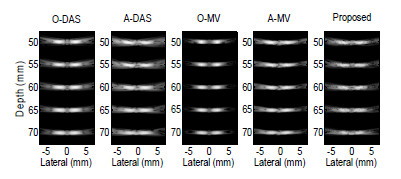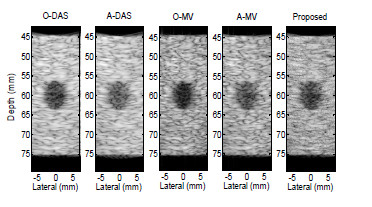Keywords: Ultrasound imaging, Adaptive beamforming, Phase aberration
Minimum variance (MV) adaptive beamforming method has been applied in medical ultrasound imaging to improve lateral resolution. Compared with the conventional delay-and-sum (DAS) beamforming method, it can reduce aperture size, increase frame rates and penetration depth without sacrificing imaging quality. However, such adaptive beamforming methods have high sensitivity to model assumptions.
Due to the inhomogeneity of human tissues, sound speed varies and there exists a certain amount of time-delay error for each channel which is referred to as phase aberration. Under such circumstance, there is a significant degradation of these adaptive beamforming methods’ performance.
In order to maintain its good performance under more practical circumstances, a robust minimum variance adaptive beamforming method has been proposed by researchers from the Institute of Acoustics of the Chinese Academy of Sciences.
To decorrelate the coherent signal received from each channel, spatial averaging technique is utilized in medical ultrasound imaging. Compared with the commonly used diagonal loading method, the sample covariance matrix is reconstructed with a forward-backward method, which could reduce its sensitivity to the perturbation of received signal.
In the standard MV method, the presumed steering vector is simply a vector of ones in the assumption that all the received data is aligned, which means the effect of phase aberration is usually omitted. However, there is a certain amount of error between the actual steering vector and the presumed one. Therefore, the actual steering vector should be estimated via the reconstructed covariance matrix to compensate the performance degradation brought by phase aberration in more practical situations.
In this proposed method, the steering vector is estimated via maximizing the output beamformer power, which is turned into a quadratic convex optimization problem with essential constraints. The proposed robust adaptive weight vector is finally computed with the above reconstructed sample covariance matrix and estimated steering vector to achieve more robust performance against phase aberration.
The algorithm is verified via simulations with Field II program and a near-field phase screen model is used to describe phase aberration. Two columns of point targets are first simulated which show that the proposed method could enhance the amplitude of mainlobe and maintain its width compared with standard MV method (see Fig. 1).
Afterwards, a simulation on an anechoic cyst target show that the proposed method improves the contrast ratio by 1.95dB and 2.06dB compared with DAS method and standard MV method respectively (see Fig. 2). The simulations turn out that the proposed method is robust against phase aberration and maintains its performance for improving imaging quality.

Fig.1 Simulation results of B-mode imaging for point targets (Image by XIA)

Fig. 2 Simulation results of B-mode imaging for an anechoic cyst target (Image by XIA)
References:
XIA Xinyuan, LI Ping, WU Wentao, MENG Xiaohui. Robust Minimum Variance Beamforming Applied to Ultrasound Imaging in the Presence of Phase Aberration. Piezoelectricity, Acoustic Waves, and Device Applications (SPAWDA), 2014 Symposium on, ISBN 978-1-4799-6424-6, IEEE (pp. 122-125, Oct. 30 2014-Nov. 2, 2014, Beijing, China). DOI: 10.1109/SPAWDA.2014.6998541
Contact:
XIA Xinyuan
Institute of Acoustics, Chinese Academy of Sciences, 100190 Beijing, China
Email: xiaxinyuan11@mails.ucas.ac.cn


